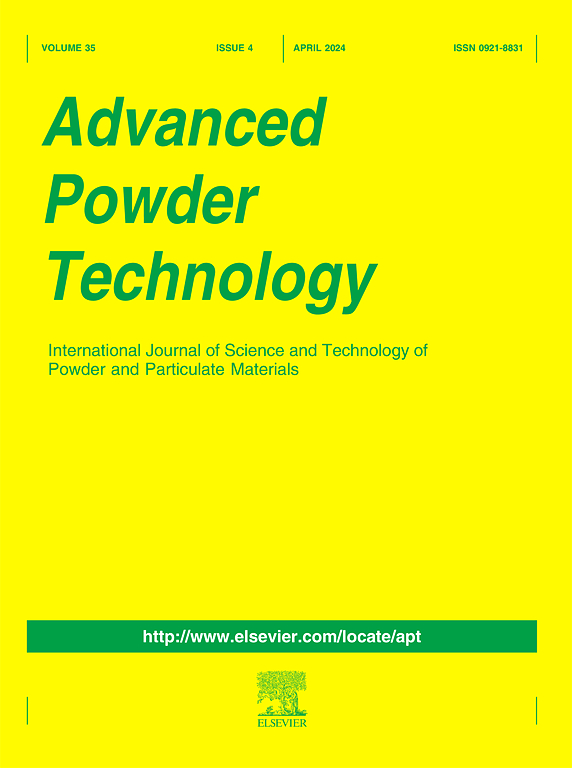Computational dynamics modeling of gas–solid flow behaviors in a spouted bed by Coupled Eulerian-Eulerian-Lagrangian method
IF 4.2
2区 工程技术
Q2 ENGINEERING, CHEMICAL
引用次数: 0
Abstract
Optimizing gas-particle flow conditions is the key to improve heat and mass transfer capacity of multiphase systems. The Eulerian and Lagrangian approaches represent two standard numerical frameworks for characterizing gas–solid two-phase flows. Comparing and optimizing the similarities and differences between them is of great significance for guiding numerical modeling, revealing and predicting the intrinsic behavior of gas–solid two-phase flow. In this study, a self-developed Coupled Eulerian-Eulerian-Lagrangian (CEEL) method is employed to investigate the flow process of a fluidized bed. The particles are treated as Euler solid phase (ESP) and Lagrangian discrete particles (LDP) respectively to facilitate the comparison of the Eulerian and Lagrangian methods under real-time conditions and the same gas phase conditions. Solid-phase velocity and granular temperature are predicted by the two methods, and the diffusion characteristics of particles are quantified through their trajectory. The results show that there is little difference in the time-averaged axial velocity of the ESP and LDP, which is basically consistent with the experimental results. The instantaneous velocities of ESP and LDP are almost the same except in confined spaces, while the difference in granular temperature between the two is more significant in low concentration regions.

喷注床内气固流动特性的欧拉-欧拉-拉格朗日耦合计算动力学建模
优化气相流动条件是提高多相系统传热传质能力的关键。欧拉法和拉格朗日法是表征气固两相流的两种标准数值框架。比较和优化它们之间的异同,对于指导数值模拟、揭示和预测气固两相流动的内在行为具有重要意义。本文采用自主开发的欧拉-欧拉-拉格朗日(CEEL)耦合方法对流化床的流动过程进行了研究。将粒子分别作为欧拉固相(ESP)和拉格朗日离散粒子(LDP)处理,以便于实时条件下和相同气相条件下欧拉和拉格朗日方法的比较。两种方法分别预测了固相速度和颗粒温度,并通过颗粒的运动轨迹量化了颗粒的扩散特性。结果表明,ESP和LDP的时间平均轴向速度差异不大,与实验结果基本一致。除密闭空间外,ESP和LDP的瞬时速度基本相同,而在低浓度区域,两者的颗粒温度差异更为显著。
本文章由计算机程序翻译,如有差异,请以英文原文为准。
求助全文
约1分钟内获得全文
求助全文
来源期刊

Advanced Powder Technology
工程技术-工程:化工
CiteScore
9.50
自引率
7.70%
发文量
424
审稿时长
55 days
期刊介绍:
The aim of Advanced Powder Technology is to meet the demand for an international journal that integrates all aspects of science and technology research on powder and particulate materials. The journal fulfills this purpose by publishing original research papers, rapid communications, reviews, and translated articles by prominent researchers worldwide.
The editorial work of Advanced Powder Technology, which was founded as the International Journal of the Society of Powder Technology, Japan, is now shared by distinguished board members, who operate in a unique framework designed to respond to the increasing global demand for articles on not only powder and particles, but also on various materials produced from them.
Advanced Powder Technology covers various areas, but a discussion of powder and particles is required in articles. Topics include: Production of powder and particulate materials in gases and liquids(nanoparticles, fine ceramics, pharmaceuticals, novel functional materials, etc.); Aerosol and colloidal processing; Powder and particle characterization; Dynamics and phenomena; Calculation and simulation (CFD, DEM, Monte Carlo method, population balance, etc.); Measurement and control of powder processes; Particle modification; Comminution; Powder handling and operations (storage, transport, granulation, separation, fluidization, etc.)
 求助内容:
求助内容: 应助结果提醒方式:
应助结果提醒方式:


